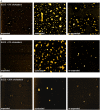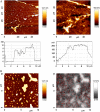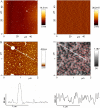An elevated level of cholesterol impairs self-assembly of pulmonary surfactant into a functional film
- PMID: 17483162
- PMCID: PMC1896251
- DOI: 10.1529/biophysj.107.106310
An elevated level of cholesterol impairs self-assembly of pulmonary surfactant into a functional film
Abstract
In adult respiratory distress syndrome, the primary function of pulmonary surfactant to strongly reduce the surface tension of the air-alveolar interface is impaired, resulting in diminished lung compliance, a decreased lung volume, and severe hypoxemia. Dysfunction coincides with an increased level of cholesterol in surfactant which on its own or together with other factors causes surfactant failure. In the current study, we investigated by atomic force microscopy and Kelvin-probe force microscopy how the increased level of cholesterol disrupts the assembly of an efficient film. Functional surfactant films underwent a monolayer-bilayer conversion upon contraction and resulted in a film with lipid bilayer stacks, scattered over a lipid monolayer. Large stacks were at positive electrical potential, small stacks at negative potential with respect to the surrounding monolayer areas. Dysfunctional films formed only few stacks. The surface potential of the occasional stacks was also not different from the surrounding monolayer. Based on film topology and potential distribution, we propose a mechanism for formation of stacked bilayer patches whereby the helical surfactant-associated protein SP-C becomes inserted into the bilayers with defined polarity. We discuss the functional role of the stacks as mechanically reinforcing elements and how an elevated level of cholesterol inhibits the formation of the stacks. This offers a simple biophysical explanation for surfactant inhibition in adult respiratory distress syndrome and possible targets for treatment.
Figures







Similar articles
-
Methyl-beta-cyclodextrin restores the structure and function of pulmonary surfactant films impaired by cholesterol.Biochim Biophys Acta. 2010 May;1798(5):986-94. doi: 10.1016/j.bbamem.2009.12.003. Epub 2009 Dec 16. Biochim Biophys Acta. 2010. PMID: 20018170
-
Electrical surface potential of pulmonary surfactant.Langmuir. 2006 Nov 21;22(24):10135-9. doi: 10.1021/la061718g. Langmuir. 2006. PMID: 17107011
-
Effect of SP-C on surface potential distribution in pulmonary surfactant: Atomic force microscopy and Kelvin probe force microscopy study.Ultramicroscopy. 2009 Jul;109(8):968-73. doi: 10.1016/j.ultramic.2009.03.046. Epub 2009 Mar 28. Ultramicroscopy. 2009. PMID: 19398273
-
Lipid-protein interactions of hydrophobic proteins SP-B and SP-C in lung surfactant assembly and dynamics.Pediatr Pathol Mol Med. 2001 Nov-Dec;20(6):445-69. doi: 10.1080/pdp.20.6.445.469. Pediatr Pathol Mol Med. 2001. PMID: 11699574 Review.
-
Protein-lipid interactions and surface activity in the pulmonary surfactant system.Chem Phys Lipids. 2006 Jun;141(1-2):105-18. doi: 10.1016/j.chemphyslip.2006.02.017. Epub 2006 Mar 20. Chem Phys Lipids. 2006. PMID: 16600200 Review.
Cited by
-
Exposure to polymers reverses inhibition of pulmonary surfactant by serum, meconium, or cholesterol in the captive bubble surfactometer.Biophys J. 2012 Oct 3;103(7):1451-9. doi: 10.1016/j.bpj.2012.08.024. Epub 2012 Oct 2. Biophys J. 2012. PMID: 23062337 Free PMC article.
-
Surfactant Dysfunction in ARDS and Bronchiolitis is Repaired with Cyclodextrins.Mil Med. 2018 Mar 1;183(suppl_1):207-215. doi: 10.1093/milmed/usx204. Mil Med. 2018. PMID: 29635617 Free PMC article.
-
Lung surfactant protein SP-B promotes formation of bilayer reservoirs from monolayer and lipid transfer between the interface and subphase.Biophys J. 2011 Apr 6;100(7):1678-87. doi: 10.1016/j.bpj.2011.02.019. Biophys J. 2011. PMID: 21463581 Free PMC article.
-
Atomic force microscopy studies of functional and dysfunctional pulmonary surfactant films, II: albumin-inhibited pulmonary surfactant films and the effect of SP-A.Biophys J. 2008 Sep 15;95(6):2779-91. doi: 10.1529/biophysj.108.130732. Epub 2008 Jun 6. Biophys J. 2008. PMID: 18539636 Free PMC article.
-
Metabolomics analysis reveals that benzo[a]pyrene, a component of PM2.5, promotes pulmonary injury by modifying lipid metabolism in a phospholipase A2-dependent manner in vivo and in vitro.Redox Biol. 2017 Oct;13:459-469. doi: 10.1016/j.redox.2017.07.001. Epub 2017 Jul 4. Redox Biol. 2017. PMID: 28715731 Free PMC article.
References
-
- von Neergard, K. 1929. New views on a subject of the mechanics of breathing: the retractive force of the lung in dependence of the surface tension in the alveoli. Z. Ges. Exp. Med. 66:373–381.
-
- Schurch, S. 1982. Surface tension at low lung volumes: dependence on time and alveolar size. Respir. Physiol. 48:339–355. - PubMed
-
- Bachofen, H., and S. Schurch. 2001. Alveolar surface forces and lung architecture. Comp. Biochem. Physiol. 129:183–193. - PubMed
-
- Lewis, J. E., and R. Veldhuizen. 2003. The role of exogenous surfactant in the treatment of acute lung injury. Annu. Rev. Physiol. 65:613–642. - PubMed
-
- Taeusch, H. W., and K. M. W. Keough. 2001. Inactivation of pulmonary surfactant and the treatment of acute lung injury. Pediatr. Pathol. Mol. Med. 20:519–536. - PubMed
Publication types
MeSH terms
Substances
LinkOut - more resources
Full Text Sources
Other Literature Sources
Medical

